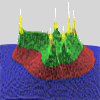Domenico Lanera
Curriculum Vitae
![]()
| bottom|
![]() back
|
back
|
![]() Home
|
Home
|
![]() DL Profile
|
DL Profile
|
![]() Engineering
|
Engineering
|
|
|
Started out in Chicago in 1972 as a Technical Assistant at IIT Research Institute, an affiliate of IIT (Illinois Institute of Technology), the university where he had just completed his studies in electrical engineering (BSEE). IITRI performs R&D under contract to government and industry in a variety of physical sciences. Working as a radar engineer on six tasks for the FAA; he distinguished himself by his technical skills, intuitive problem solving, and leadership in the field (heading a crew of four). Was promoted to Assistant Engineer in 1974. Noteworthy contributions include the resolution of radar false targets, which he traced to reflections from nearby buildings; the development of instrumentation for time-lapse photography of radar displays; and the compilation of radar coverage algorithms for two important radar siting reference manuals (terminal and en-route). |

|
|
While carrying out radar siting assignments, he learned Fortran computer programming in the mainframe environment of the time (Univac). Demonstrated remarkable computer aptitude in graphics and data manipulation to enhance the delivery of engineering products, such as computer-generated radar coverage. | index | |

|
|
With the close of the FAA program he moved on to military radar and countermeasure systems, for IITRI was active in the electronic defense industry at the time. Was a member of various engineering teams, working within a matrix organization. Further broadened his experience through work on projects that ranged from conventional fields such as radio communications (laying out cell-based radio systems for police departments) to specialized electromagnetic compatibility (EMC) effects such as EMP (the lightning-like, electromagnetic pulse that results from nuclear detonations). |

|
|
These were fruitful years during which he acquired experience in a variety of new fields, working in a fertile research environment. His work continued to be appreciated, and was promoted to Associate Engineer in 1977. Gained a master level of expertise in computer programming, developing at least three customized engineering analysis software packages. His masterwork was ELFIA (extremely low frequency interference analysis), a 6,000 line code with integrated analysis, engineering, and graphics outputs that was key to a successful U.S. Navy communications system and that continues to be used to this day. | index | |

|
|
With his assignments he received increasing levels of responsibility, which led to recognition of his capacities as a manager in a technology-rooted industry marked by diversity and constant changes. During this same period, he continued his formal education with studies in business administration and received an MBA from the University of Illinois at Chicago in 1983. |
|
|
Was picked for the lead role in the restoration of the ELF compatibility system in Wisconsin in 1981 with a promotion to Research Engineer. This Wisconsin system was an experimental radio transmitter of large scale (28 miles of antenna) that had been used to prove the feasibility of communication by radio with submerged submarines, and had later been abandoned. This assignment, although resulting in part from his commanding work on ELFIA, led to a shift in emphasis from R&D to field operations, dealing with pragmatic engineering design and construction matters. This was a retrofitting job in the electric utility industry, a new sector with differentiated technologies in power and telephone. Was instrumental in the transformation of this experimental facility into an operating system, managing the complex interference problem between the radio transmitter and three utilities with a staff of four and input from a consulting engineering firm. His work on this project covered a broad range that included problem solving, engineering design, field construction, contracting support, certification testing, and personnel training. |

|
|
In his leadership role, he was a dynamo of continuous improvements not only in engineering but in project organization and data management as well. His most significant accomplishments were in three areas: devising new mitigation solutions, such as grounding of every pole in the interference area and utilization of ungrounding transformer for high-risk locations; redesigning field data collection around the concept of special vehicles equipped with customized instrumentation and docking appurtenances; and organizing information with electronic databases indexed to maps. These innovations provided systematic and robust improvements in data collection, improving data quality, tripling staff effectiveness in the field, and more than halving related costs. Some of his innovative concepts became industry standards, such as the grounding of every pole that is now standard rule in rural Wisconsin (1997). |


|
|
It was during this experience in the early 1980s that he got involved with databases, creating a first-generation application of database and computerized data collection (NEC 8201 portable PC, modems, and a VAX mainframe), an important theme in his future work. | index | |
|
|
Promoted to Senior Engineer in 1984, became the lead engineer for
the environmental compatibility assurance program (ECAP) in Michigan
when President Reagan approved construction of an ELF radio
transmitter in that state. The construction project, which lasted
about eight years and represented a watershed in technology and
accomplishments, was shaped by his original contributions.
Promoted to Program Manager in 1988, became the ECAP manager
of the Michigan facility. His accomplishments, outstanding in scope
and strength, underscore his wide-ranging and exceptional ability to
lead complex new technologies where vision and creativity are just as
important factors for success as traditional skills in engineering
and management. His accomplishments spread over many fronts.
|

|
|
Operational Management
Organized operations for engineering, contracting, construction,
testing and maintenance. The project, affecting a rural area of
about 1,000 square miles and 2,500 residential customers, consumed
about $40 million to modify the facilities of three power companies,
three telephone companies, three cable companies, three mines, and
two dozen commercial operations. The reporting staff grew to about 20,
with several consultants. Provided many other administrative
functions: facility and personnel management, budgeting, subcontractor
recruiting, bidding evaluation, negotiating, contract administration,
and customer support.
|

|
|
Professional Contributions
Advanced the understanding of electromagnetic compatibility and
developed new mitigation tools and techniques. For example,
introduced improved grounding, which later augmented with deep
grounding techniques to reduce inductive interference on utility
systems. The impact of this work extended beyond the project itself,
having a direct relevance to the dairy farm industry, which was
struggling with the stray voltage issue, and to the EMF community,
which was interested in the magnetic field inside the residence.
His contributions have been presented at various symposia, and
published in more than a dozen papers and articles.
|

|
|
Advanced Studies
Contributed original analyses in electrical safety on utility systems.
Conducted surveys of power quality and 60Hz residual neutral voltage,
providing exemplary statistical characterizations of seasonal effects.
Studied the role of urban plumbing on grounding systems.
Led the development of risk analysis techniques to manage more
effectively the complex relations between probabilistic events
and maintenance requirements. Expanded these studies to parameterize
project tasks that had begun as ad-hoc activities. Streamlined the
activities of this unique project along the lines of conventional
projects with budgetary restraint and cost-effectiveness metrics,
cutting redundant resources.
|

|
|
Product Development
Personally contributed the idea for nearly two dozen products and supervised
their development. These products included special tools and testing
instrumentation; insulating joints for power, telephone, and cable
systems; and sophisticated devices such as the "smart switch."
The latter is an add-on device to the residential power meter
with built-in computer control that provides smart power-quality
protective functions and data collection capabilities.
|

|
|
Engineering Design and Problem Solving
Contributed to and supervised engineering design in unconventional areas
such as power distribution line undervoltage control and telephone
noise reduction. Was very proactive in generating solutions,
framing strategies, negotiating agreements, writing specifications,
developing protocols, and outlying procedures. Along the way
addressed many unique and special problems, such as ingress on cable
systems and transformer leakage causing stray voltage.
|

|
|
Computer Applications
This project coincided with a period in the computer industry that saw
the phenomenal proliferation of the PC and desktop applications,
with radical transformations taking place in the office, on workstations,
and in the field. Incorporated each generation of new developments
into the project, with firsts in desktop applications (WordPerfect Suite,
Microsoft Office Suite, Lotus software), CAD applications (Generic
Cad, AutoCAD), relational database applications (Symphony, Paradox,
Access), computer graphics (Presentation, Freehand, Photoshop,
Illustrator), spreadsheets (Lotus 1-2-3, Quattro Pro, Excel),
statistical Packages (Statplan), and engineering applications
(Spice, Mathcad, Emcalc), and desktop publishing (Pagemaker, Publisher).
Early to adopt computer technologies, provided computer training
material, customized engineering spreadsheets, electronic data
processing systems, and operation support with relational databases.
| index | |


|
|
Promoted to Engineering Advisor in 1992, expanded into electromagnetic fields health effects (EMF). Seeking to develop new work, contributed well-received presentations and papers at conferences (U.S. Department of Energy, Bioelectromagnetics Society, American Power Conference). His most valuable contribution was to the understanding of grounding currents as a source of EMF in the residence, earning him wide professional recognition. As a result, was inducted into the Bioelectromagnetics Society. Partly as a result of his promotional activity in this area, IITRI was successful in garnering substantial amounts of EMF work from DOE, EPRI, and NIEHS during the mid-1990s. This was the beginning of his involvement in marketing, a role that was soon to expand. The EMF question, however, evolved into a non-issue in the United States in the late 1990s, with a corresponding decline in business opportunities. |
 
|
|
Maintained a directing role in the Michigan ECAP project, which is now a full operating system. Continues to provide his unique knowledge and expertise, for which IITRI officially recognized him in 1997 with its Commitment to Excellence Award. Has contributed further by developing cost-effective measures and cost saving programs that have improved effectiveness by nearly 35%. Has also contributed to the modernization of the project, introducing concepts such as remote alarming and remote data monitoring, which are still under development. Is also studying permanent solutions that remove the problem rather than mitigate for the effects; this reduces the need for a maintenance program, with substantial savings and improved safety. | index | |

|
|
His sustaining work in informatics bloomed into a primary interest
with the advent of the Internet, which provides him with powerful
new tools to work out his talents in providing innovative and
advanced new solutions, and constructing novel information systems.
Pursued interests in the "Webification" of various
engineering functions, the re-engineering of business activities
around information flow, and various e-business applications.
|

|
|
In conjunction with a company restructuring and under the leadership of new management, he has taken on increasing responsibilities for marketing coordination and business development. Prepared marketing approaches and designed products such as flyers and brochures as well as actively promoting potential clients. |

|
|
Contributed a number of projects for new business development. One is a marketing plan to promote the engineering capabilities of the division in EMF, power quality, energy, and communications to building owners and other large real estate and commercial facilities. His most significant contribution has been in IT, developing and promoting a new concept for a Web-based network to support operation and management of technical projects, utilizing VPN technologies. Prepared a live concept demonstration to show its usefulness and advantages. At a presentation to a government sponsor in February 1999, the demonstration received an enthusiastic response. | index | |

|
|
Demonstrates a prolific career diversified by industry and
responsibilities; started out in leading-edge electronics
engineering of the 1970s, rose to management in the resurgent
business of the 1980s, and expanded into marketing and the
empowering information technologies of the 1990s.
He is technology solution enabler. |

|
| top |
![]() Back
|
Back
|
![]() Home
|
Home
|
![]() DL Profile
|
DL Profile
|
![]() Engineering
|
Engineering
|
| Biographical Sketch
| Resume
| Curriculum Vitae
| Publications
| Scrapook |
|
|
|
Copyright © 1998, Lanera.com. All rights reserved. |